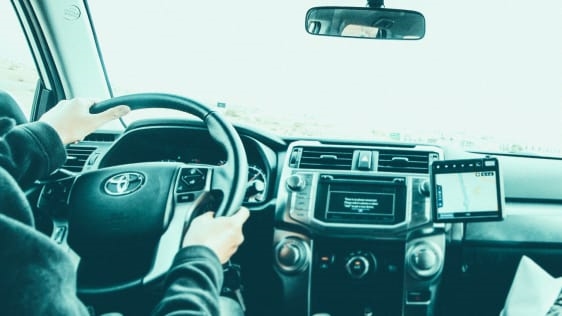This Is Why It’s So Hard To Calculate How Much Uber Drivers Earn
Last week, a working paper from MIT claimed that a third of Uber and Lyft drivers actually lose money from their on-demand work. It caught the attention of lots of publications, including ours, and in the wake of mounting criticism, Uber rushed to debunk the findings, calling the study flawed and citing past contradictory research. Other studies have estimated that drivers, on average, earn between $15.68 and $21.07 per hour.
Uber’s mild-mannered CEO, Dara Khosrowshahi, even chimed in to smear the study with a charming tweet, as did several academics. All the while, drivers piled into comment sections and Twitter threads to say the study was consistent with their own experience.
The kerfuffle over driver pay is demonstrative of a larger problem within the gig economy, which is that there isn’t a lot of data. Driver earnings vary greatly, as do their expenses. With so much opacity, its easy for Uber and other ride-hail companies to control the messaging around wages. It also leaves them open to criticism from pro-labor groups, which are already hostile to the gig economy.
“The ride-share model invites wage theft, because it’s such an atomized workforce,” says Chris Townsend, director of field mobilization with the Amalgamated Transit Union. “It’s very rare that they talk together, they all compete with each other to an extent, they’re alone in the car except when they have passengers, and it’s easy pickings for the companies that design these algorithms that run these things.”
Unreliable Data, Flawed Studies
The study that has everyone worked up was conducted by the Massachusetts Institute of Technology’s Center for Energy and Environmental Policy Research (CEEPR). Using the Rideshare Guy’s 2017 Uber and Lyft Driver survey, which accrued self-reported data from 1,100 drivers in 2017, the study determined that median profits were $3.37 per hour. It also said that 74% of drivers earn less than minimum wage and a third of drivers were actually losing money from working for a ride-hail service. It assessed that a median driver takes on costs of $0.30 per mile
In a rebuttal to the working paper, Jonathan Hall, Uber’s chief economist, noted that the researcher made bad assumptions about three already poorly worded questions from the Rideshare Guy survey. This, he wrote, is what led CEEPR to its extremely low earnings figures.
Stephen Zoepf, executive director of the Center for Automotive Research at Stanford and the lead researcher on the CEEPR study, admitted the criticism is valid. “What Hall and Khosrowshahi’s assessment laid bare was an assumption about revenue that I made in the absence of public ride-hailing data and a paucity of independent studies outside Uber’s own analyses,” he said in a letter.
He said he plans to revise the working paper per Hall’s suggestion, though it will take a few weeks. In the meantime, he released an initial assessment using two methods. In the first, he used monthly revenue numbers when available and a working schedule to determine an hourly wage. In the second method, he used hourly self-reported hourly revenue.
With the adjustments using the first methodology, Zoepf says median profit rises to $8.55 per hour. Still, 54% of drivers earned less than the 2016 minimum wage in their respective states, while 8% lost money on driving. Using the second methodology, median profit rises to $10 per hour. The percentage of drivers who earned less than minimum wage after expenses in their region dropped to 41%, and only 4% of drivers lost money from their ride hail job.
However, even this estimate is still probably flawed. “Self-reported income data is notoriously difficult, regardless of the work arrangement,” says Alastair Fitzpayne, executive director of the Aspen Institute Future of Work Initiative. “People tend, for a number of reasons, to either over or under report their earnings on surveys.”
That would also make one of the only real independent data collections—the Rideshare Guy’s annual survey—largely unreliable.
This deficit of information has made it extremely difficult to draw any conclusions about how Uber is paying workers. Uber pays drivers based on how far they drive and how long it takes them to get somewhere, but prices per mile and minute vary based on location. While the company has given up data for some studies, the available information is still pretty limited.
Uber and Lyft are tight-fisted with data because of concerns over driver privacy and intellectual property. They are also probably loathe to give out information that might lead to negative press. As such, requests for data can get tangled up for months or years as corporate lawyers figure out what data sets they’re willing to share and under what circumstances. While Uber’s Hall has co-authored several studies using the company’s data, none of them have really shed much light on the nuance of driver earnings.
Researchers are also likely to be wary of Uber, which hasn’t always been honest about driver wages. Last year, the company settled with the FTC for overpromising on driver wages in advertisements. “The data we do have about the earnings of workers on labor intermediary platforms, like ride-hailing platforms, is very inconclusive,” says Fitzpayne. “Surveys conducted by Intuit, Earnest, and others have shown a huge range in how much people earn through this type of work, from $5 to over $60 per hour.” Uber drivers make different amounts based on when and where they drive and, as one study indicated, how quickly they complete trips.
Who Makes What?
Fitzpayne says one of the big questions is how we even quantify how much Uber drivers make. Past studies have tried to estimate a per-hour wage, but given that Uber drivers are not paid for the time they spend going to pick up a rider, or waiting to be matched with a rider, per hour isn’t particularly relevant.
There are also big questions about driver costs, which the CEEPR MIT study attempted to quantify. Gas and tolls might be easy to track, but car depreciation is more nebulous when the driver is using the vehicle commercially and personally. For two years, Uber also ran an extremely expensive car-leasing program that ate into driver earnings. The company has since dissolved that program, but the cost of buying or renting a car is an additional burden for drivers who don’t own their cars outright. Drivers also foot the bill for cleaning, repairs, and maintenance.
Information about all of these hidden costs is important in order for workers to make decisions about their livelihoods. “More broadly, we need knowledge of the workforce and its earnings in order to identify where there are needs and what challenges can be addressed through policy or company-level reforms,” says Fitzpayne.
He says there should be a wide effort to collect this data, involving third-party surveys, academic studies, ride-hail companies, and even the government. It will take more than just Uber and Lyft data to understand driver wages and expenses. Indeed, the models for this type of data-sharing already exist: For example, the Idaho National Laboratory was able to cull data from Chevrolet, Nissan, and other corporations for the EV Project, which sought to understand electric vehicle use. It was a closed process under which the laboratory conducted all the analyses.
Though academics might prefer a more open study, such a scenario involving Uber and Lyft might begin to answer deeper questions about the ride-hailing industry.
(50)



